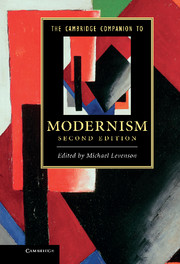Book contents
- Frontmatter
- Introduction
- 1 The metaphysics of Modernism
- 2 The cultural economy of Modernism
- 3 The Modernist novel
- 4 Modern poetry
- 5 Modernism in drama
- 6 Modernism and the politics of culture
- 7 Modernism and religion
- 8 Modernism and mass culture
- 9 Modernism and gender
- 10 Musical motives in Modernism
- 11 Modernism and the visual arts
- 12 Modernism and film
- 13 Modernism and colonialism
- Further reading
- Index
12 - Modernism and film
Published online by Cambridge University Press: 28 September 2011
- Frontmatter
- Introduction
- 1 The metaphysics of Modernism
- 2 The cultural economy of Modernism
- 3 The Modernist novel
- 4 Modern poetry
- 5 Modernism in drama
- 6 Modernism and the politics of culture
- 7 Modernism and religion
- 8 Modernism and mass culture
- 9 Modernism and gender
- 10 Musical motives in Modernism
- 11 Modernism and the visual arts
- 12 Modernism and film
- 13 Modernism and colonialism
- Further reading
- Index
Summary
I decided I liked Photography in opposition to the Cinema, from which I nonetheless failed to separate it.
Roland Barthes, Camera LucidaIt is tempting to argue that all films are Modernist, that the cinema itself is an accelerated image of modernity, like the railway and the telephone. But to do this is to miss the nostalgia inseparable from the way the medium has worked out historically, its (amply rewarded) yearning to become the twentieth century’s version of the nineteenth century’s novel. There are Modernist films, even outside the period we associate with Modernism; but the largest fact about the cinema over the hundred years since its birth is its comfortable embrace of ancient conventions of realism and narrative coherence.
When the German critic Walter Benjamin describes the strange mingling of artifice and illusion in the cinema – we know all about the tricky construction of the pictured world, which we nevertheless take as far more intimately actual than anything we could find in the live theatre – he says “the sight of immediate reality has become an orchid in the land of technology.” “In the theatre one is well aware of the place from which the play cannot immediately be detected as illusionary. There is no such place for the movie scene that is being shot. Its illusionary nature is that of the second degree, the result of cutting.”
- Type
- Chapter
- Information
- The Cambridge Companion to Modernism , pp. 268 - 283Publisher: Cambridge University PressPrint publication year: 2011



